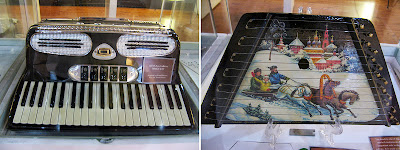
The first time I have heard of and visited the JRG Halad Museum, a museum "where Cebuano musical heritage comes alive" (the museum's tagline), was in 2012. But this museum has been around since 2010. I remember I wasn't hiding under a rock then, how come I did not know about it until 2012? Maybe I should go out more. And maybe you should, too.

Corner V Gullas St. and D Jakosalem St., Cebu City
(032) 268 2579
Tuesday to Saturday 9AM to 5PM
Monday by appointment
Admission fees:
Child/Student Php 10
Adult Php 20
Senior Citizen Free
Jeepneys that pass in front of the museum: 14D, 01K, 03A, 03L, 62B, 62C, 13B
Jeepneys that pass in front of the museum: 14D, 01K, 03A, 03L, 62B, 62C, 13B
"In this internet generation, we are being cloaked over and over with the trappings of modernity, and we are increasingly lost amidst interwoven foreign influences. There maybe no reversing or stopping this global trend but we must not entirely lose our own native identity, which defines who we essentially are." (An excerpt. Click photo to read entire passage.)

The museum is a tribute (halad is Cebuano for tribute) to Cebuano music. It tells about some Visayan music artists and Cebuano 20th century composers. What I liked best about this museum is that it has listening stations where you can listen to some old Cebuano music through modern means: a laptop or an mp3 player. Unfortunately, when I came to visit again two days ago, none of the mp3 players were charged :-(

Learn about Visayan artists and listen to their music


LP records of Pilita Corrales (left) and a listening station (right)
The museum also has phonographs, vinyl records, radios, and musical instruments on display. I didn't see any portable cassette players (you probably know this as the Walkman) and cassette tapes. Maybe I should donate my old cassette tapes. I know the children of today don't have any idea what cassette tapes are.

A working phonograph (left) and vinyl records (right)

An old–school phonograph (left) and a Balalaika, a Russian folk stringed instrument (right)

An accordion (left) and a Gusli, a Russian multi–stringed plucked instrument (right)
There is a door that opens to a stairwell. There is no sign that there's more to see upstairs, but explore it! Here you will find music-inspired art and some Philippine traditional musical instruments. Try your hand on the Maranao Kulintang Ensemble.

Some traditional instruments (left), Kulintang (center), and music–inspired art (right)
There are other sections in the museum that are not related to music. One shows paintings depicting Cebuano life events. If you understand Cebuano, I urge you to read the Cebuano descriptions for each painting...I tried that and found there are so many Cebuano words that I have not heard of. My friends and I tried to guess what some of the words meant and checked if we got it correctly through the English description. (Yes, there is a description in English, I just want you to read the Cebuano one first!)

Paintings showing Cebuano life events
The JRG (Jose R. Gullas) Halad Museum is owned by the Gullas family, who also owns the University of the Visayas (UV) and The Freeman newspaper. The museum also has a small gallery that tells about Jose R. Gullas, The Freeman newspaper, and about the UV chorale.

After taking a bunch of photos, I spot this sign.
(Today, I found out through facebook that picture taking is allowed, just without flash.
Whew. Good thing the flash on my seven–year–old camera is broken.)
